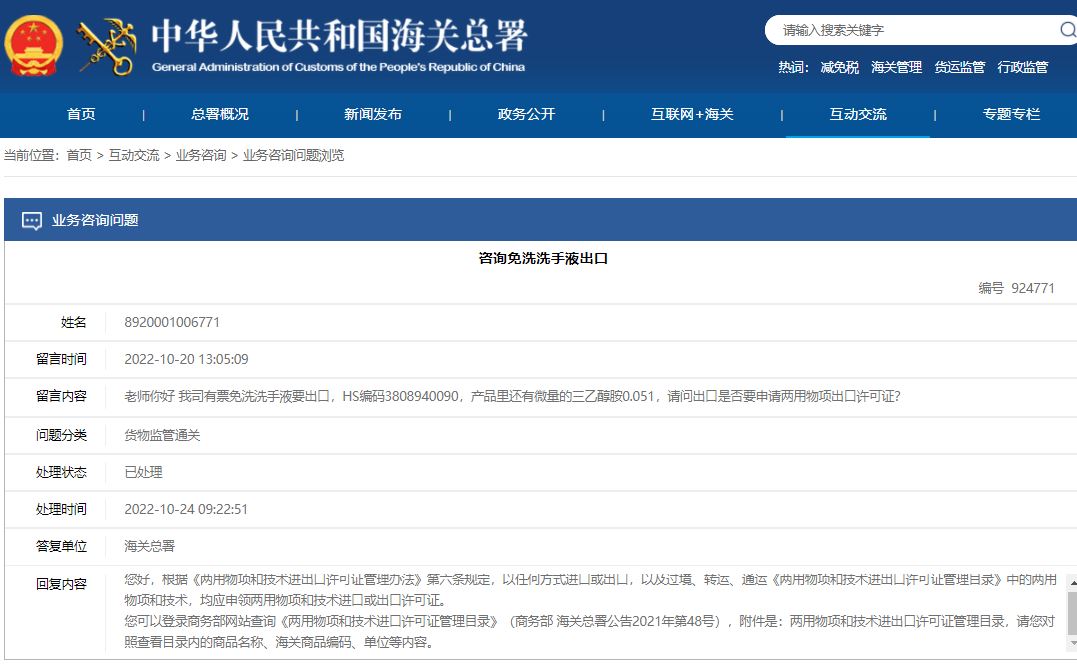Triethanolamine has been getting a lot of attention recently but there is some confusion over mixtures containing it. In general, the concentration of triethanolamine in cosmetics is less than 0.5%, accounting for a low proportion. According to Article 57 of the Detailed Rules on the Implementation of Administration Regulations of the People’s Republic of China on the Administration of Monitored and Controlled Chemicals (MCCs), when the concentration of MCCs is lower than a certain concentration threshold, data declaration and import and export licensing can be exempted.
Recently, there was an inquiry on the official website of the General Administration of Customs about the necessity of applying for an Import/Export License for hand sanitizers containing a trace quantity of triethanolamine (0.051).
The General Administration of Customs replied on October 24, 2022 that according to Article 6 of the Measures for the Administration of Import and Export Licenses for Dual-Use Items and Technologies, import or export of dual-use items and technologies in any way, as well as transit, transshipment and transportation of dual-use items and technologies, must apply for import or export license for dual-use items and technologies. The reply is consistent with the previous provisions. The main reason is that the limits for the exemption of low-concentration triethanolamine are still under consideration, and relevant documents have not yet been issued.

The General Administration of Customs has sought advice from the Office for the Prohibition of Chemical Weapons of the People's Republic of China (OPCW) on the limitation of the import and export of mixtures containing triethanolamine by enterprises. On October 28, 2022, the General Administration of Customs of the People's Republic of China issued a letter, clarifying the supervision requirements for mixtures containing triethanolamine as follows:
Triethanolamine, which acts as a PH regulator in cosmetics, detergents, and other commodities, will generally neutralize the acidic substances in them. If the test report shows that triethanolamine monomers cannot be detected, it proves that triethanolamine has been fully reacted and there is no free triethanolamine. According to the Regulations on the Administration of Monitored and Controlled Chemicals, in such circumstances, an import and export license is not required. The Customs can exempt products without triethanolamine monomers from the verification of the Import and Export License for Dual-Use Items and Technologies by virtue of the test report issued by relevant testing agencies.

The issuance of this letter indicates that the management of triethanolamine is further standardized. The requirements for the import and export of cosmetics containing triethanolamine are to be adjusted according to the actual situations, as triethanolamine is indispensable for some cosmetics and detergents.
To sum up, if the triethanolamine only serves as a pH regulator in cosmetics and detergents and the triethanolamine monomers cannot be detected, an import and export license is not required. In all other circumstances, an import and export license is still required, even if the concentration of triethanolamine is extremely low.
Enterprises that are allowed to handle triethanolamine import and export licenses:
Triethanolamine belongs to Category III MCCs and according to the Regulations of the People's Republic of China on the Administration of MCCs can only be operated by designated units.
At present, importers shall entrust CHINA HAOHUA or SINOCHEM to serve as their domestic consignee to handle the dual-use item license (CHINA HAOHUA or SINOCHEM will sign a contract with the foreign merchants) after they have obtained the Application Form for Users of Imported MCCs from the local CWC Office at the provincial level.
If you have any needs or questions, please contact us at service@hfoushi.com.
Further Information

